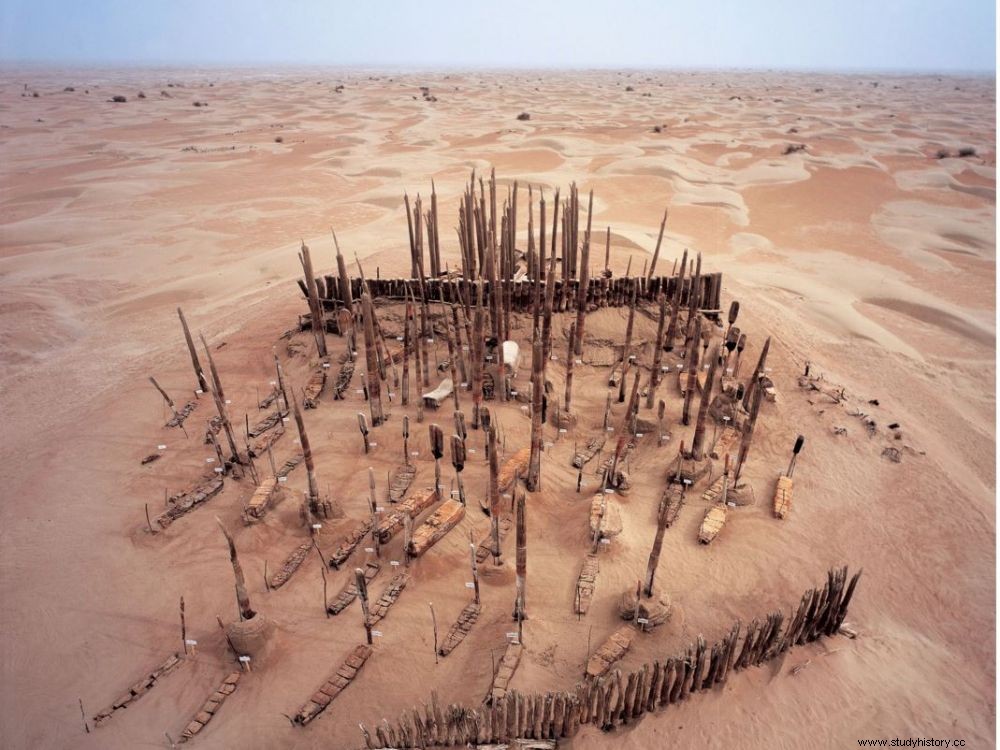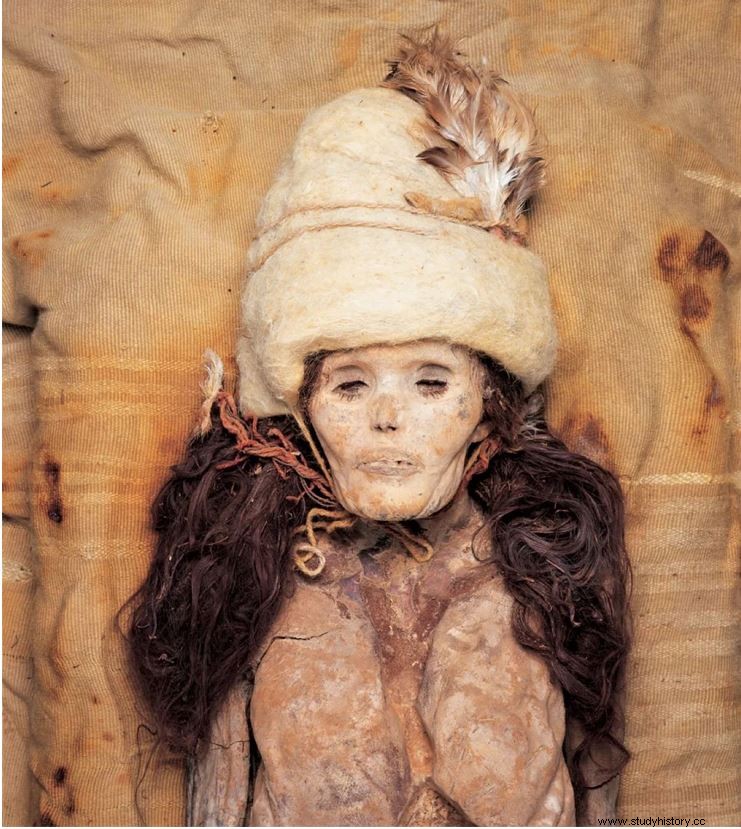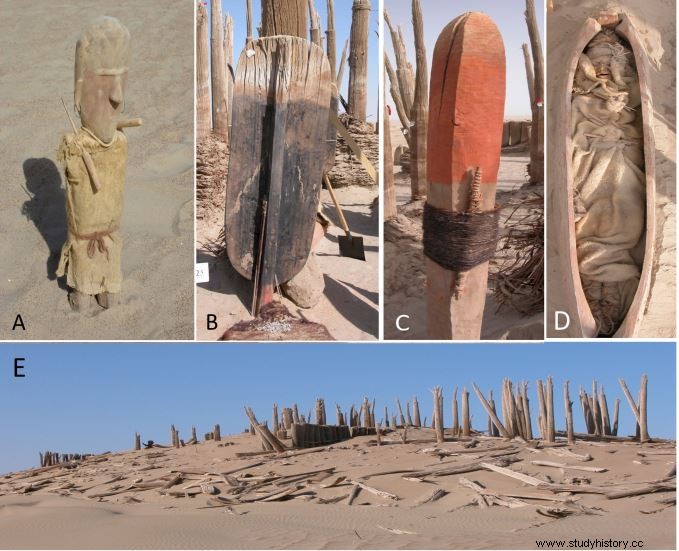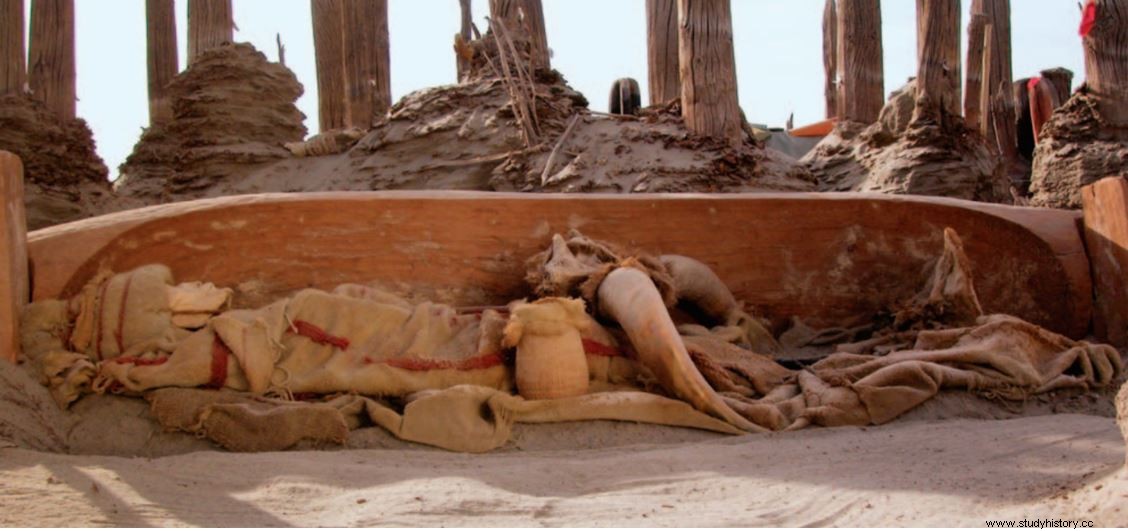The genomic study of Bronze Age mummies discovered in the Tarim Basin, China, reveals the origin of these extraordinary millennial remains. The end of a much-discussed mystery.

Aerial view of the Xiaohe Cemetery in Xinjiang Province, China, where the famous Tarim Basin mummies rest in the boat-shaped coffins.
Renowned for their "Indo-European" physical appearance, the mummies unearthed in western China in the sands of the Taklamakan desert - "the one from which there is no return " -, made headlines for decades. Their "Caucasian" features - straight noses, round eyes, light hair - and their felted and woven woolen clothes decorated with checkered patterns have long led specialists to associate these ancient cultures with Central Asia with a European origin Many theories were current to try to explain the reason for their presence in the Tarim Basin, south of the current Uyghur province of Xinjiang (formerly Chinese Turkestan). study published this Wednesday, October 27, 2021 in the journal Nature, led by an international team, has just put an end to the mystery. It determines the genetic origins of these enigmatic mummies naturally preserved for millennia due to the extreme conditions of this desert. Once believed to originate from the West, these ancient Bronze Age inhabitants were ultimately revealed to be of local origin:"a genetically isolated but culturally cosmopolitan population" , according to the signatories of the article.

Wearing a felt cap, this 4,000-year-old long-haired young woman was discovered in Xiaohe Cemetery in the Tarim Basin, Xinjiang, China. Credits:Wenying Li, Xinjiang Institute of Cultural Relics and Archaeology.
What were the theories until then concerning the origin of these remains exhumed among others in the cemetery of Xiaohe, says the site of the Thousand Mummies (read box ) reported in 1934 by Swedish explorer Folke Bergmann but only found in 2003 by archaeologist from the Xinjiang Institute of Archeology, Idriss Abdurussul? "The physical appearance of the Tarim Basin mummies had led some researchers to speculate that they might be descendants of the Yamnaya herders, a highly mobile Bronze Age society found on the steppes of the Black Sea in southern Russia; while others place this origin among the desert oasis cultures of Central Asia, particularly that of the Bactro-Margian Archaeological Complex (BMAC), (or Oxus Civilization editor's note), a group genetically linked to the first farmers of the Iranian plateau" , explain the authors. In an attempt to solve the riddle, researchers from Jilin University (China), the Institute of Paleontology and Paleoanthropology of the Max Planck Institute (Germany), the National University of Korea and the Harvard University (United States) analyzed the genomes of thirteen of these mummies from the Tarim Basin dated from 2100 to 1700 years before our era, and of five others dated from 3000 to 2800 years before our era from a region neighbor further north, in the basin of Dzungaria. "To their surprise, they thus discovered that the Tarim Basin mummies were direct descendants of a local population that was once widespread in the Pleistocene, and which largely disappeared at the end of the last ice age, there about 10,000 years old ". Populations identified with Ancient North Eurasians (ANE), of which only faint traces are found in current populations, "those indigenous to Siberia and the Americas holding the highest known proportions" say the researchers. In addition, individuals from the Tarim Basin from the Xiaohe site showed strong traces of milk protein in their dental calculus, signaling their membership in dairy pastoralism.
According to the authors of this publication, the populations of the Tarim basin would have in fact formed a hitherto unknown genetic isolate, which probably suffered an extreme bottleneck before its installation in what today corresponds to the western China. Genetically isolated, these populations would however have adopted the agropastoral practices of their neighbors, which allowed them to settle and prosper along the oases of the Taklamakan desert. "Archaeogeneticists have long been looking for Holocene ANE populations (the geological era of the last 11,000 years, editor's note) to better understand the genetic history of inner Eurasia. And we found some in the most unexpected place !” said Choongwon Jeong, a professor at the University of Seoul (Korea).
THE XIAOHE SAND MUMMIES
The current province of Xinjiang where the famous "sand mummies" of the Tarim Basin were found, named the "New Frontier" in 1884 under the Qing Dynasty (1644-1911), was incorporated into the People's Republic of China in 1949 after a very brief period of independence as the Republic of East Turkestan. Populated mainly by Uyghurs, a Turkic ethnic group that arrived in the 11th century from Mongolia, it has always been at the crossroads of the great sedentary Empires (China, India, Persia). It is also through its multiple access routes that the various Silk Roads passed at the beginning of our era, and long before them, others remained nameless, taken by populations whose traces we have only begun to find. in the 1990s, after this region had long been closed to foreigners. Between 1898 and 1934, Swedish explorers and scholars Sven Hedin and Folke Bergmann reported the presence of archaeological sites under the sands in the central region of Xinjiang. But it was not until 2003 that archaeologist from the Xinjiang Institute of Archeology, Idriss Abdurussul - co-signer of the new genetic study published in the journal Nature, found the extraordinary necropolis of Xiaohe marked by 140 poles erected like totems in the middle of the desert. Dating back to 2000 BC. J.-C, these tombs overhung by posts colored in red and black, according to the sex of the deceased, yielded hundreds of mummies.
The poplar wooden, boat-shaped coffins were covered with stretched animal skins and tamarisk flowers. Inside, the exceptionally well-preserved bodies of men and women were sometimes accompanied by bows and arrows carved from the wood of the same tree. Among these multi-millennial remains, there was above all one of the most beautiful mummies in the world. That of a young woman with long hair aged 4000 years. Wearing a felt bonnet, she wore a fringed skirt paired with a pair of boots. In Xiaohe, archaeologists have discovered a multitude of objects bearing witness to this civilization of farmers and shepherds, ranging from wooden effigies, to bracelets adorned with jade beads or wheat straw basketry.

The Xiaohe cemetery, its tombs in boats and its masts, in the heart of the Tarim Basin, in present-day Xinjiang, China. Credits:Nature

Profile view of one of the boat-shaped coffins accompanied by its mummy, in Xiaohe cemetery. Credits:Wenying Li, Xinjiang Institute of Cultural Relics and Archaeology.
